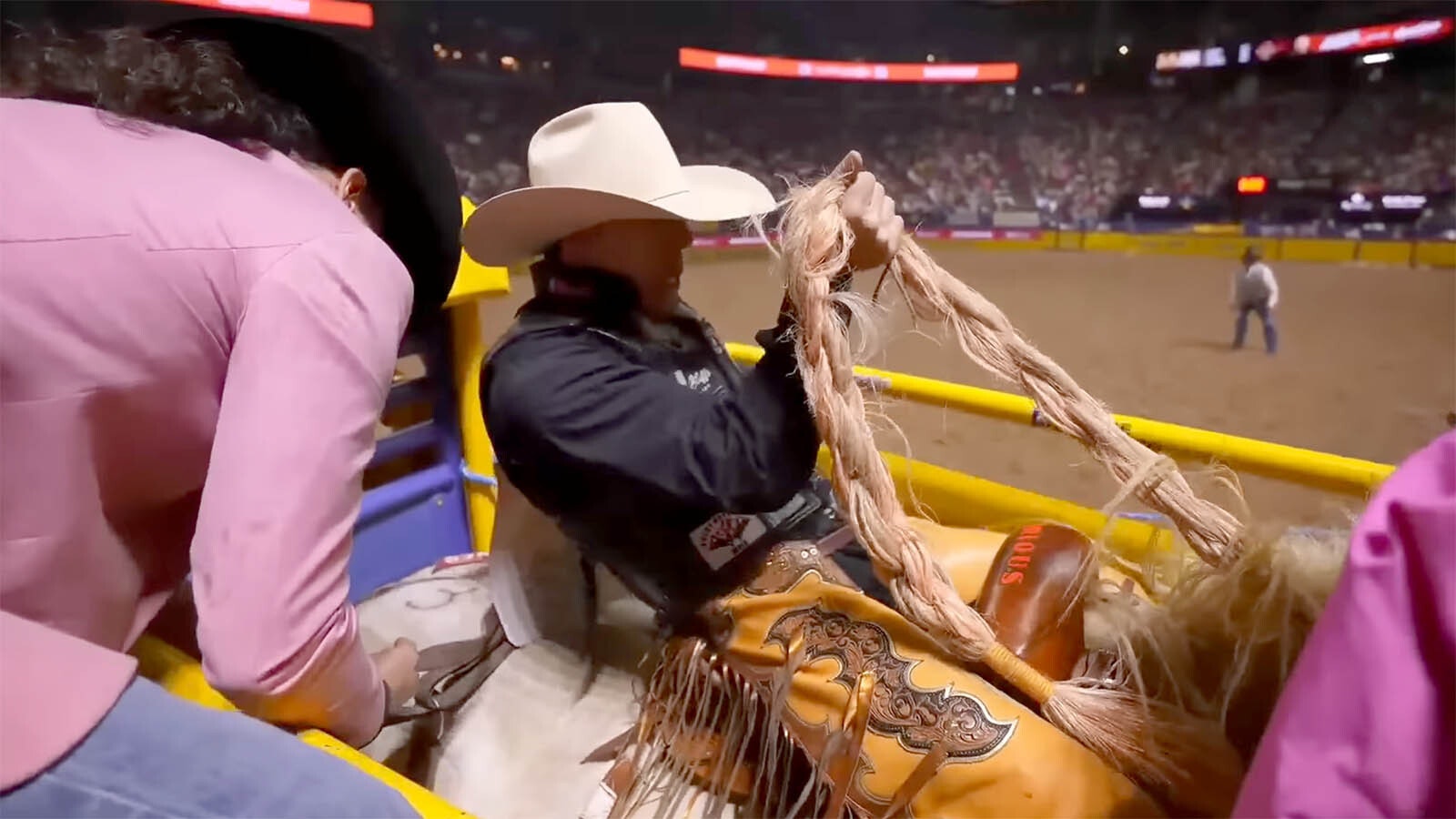Bugs Bunny and Elmer Fudd have one of the most iconic rivalries in Hollywood history. But, like any partnership, they had to find their groove before settling into a comfortable and successful working relationship.
“Wabbit Twouble” wasn’t the first cartoon to feature Bugs facing off with Elmer, but it laid the foundation for the characters’ future success as hilarious antagonists. Now in the 21st century, it’s taken on a unique life of its own thanks to the eclectic humor of the internet.
And it all happened in Wyoming — sort of. While Daffy Duck never made it to the real Thermopolis, “Wabbit Twouble” is set in the fictional Jellostone National Park, but it doesn’t take the super genius of Wile E. Coyote to link Jellostone to Yellowstone.
It’s one of the many things that makes “Wabbit Twouble” a notable entry in the colorful history of the “Looney Tunes” and technically makes Yellowstone the birthplace of one of the strangest meme icons: Big Chungus.
‘A Westful Wetweat’
“Wabbit Twouble,” directed by Bob Clampett and produced by Leon Schlesinger Productions, was the 11th cartoon featuring Bugs Bunny since the character’s debut in 1938. It premiered as a “Merrie Melodies” cartoon Dec. 20, 1941.
This was the fourth cartoon starring Bugs and Elmer Fudd, although it’s the first to feature “Fat Elmer,” a short-lived redesign of the bumbling hunter. This becomes important later.
In the cartoon, Elmer Fudd travels to Jellostone National Park for “a westful vacation in the mountains.” He’s immediately drawn to Jellowstone’s official tagline, “A Restful Retreat.”
Unfortunately for the hapless Elmer, Bugs is also relaxing in Jellostone. He gets immediately and unusually antagonistic toward Elmer, setting him up for a humiliating experience before he even parks his car.
Bugs continuously hampers Elmer’s attempts to relax in Jellostone.
In short order, the “wascally wabbit” steals Elmer’s tent and ties it in knots, paints his glasses black to make it appear he overslept and uses a tree branch to hang Elmer’s bathroom towel over a cliff while Elmer is temporarily blinded by soap.
“I do this kinda stuff to him all through the picture,” Bugs quips to the audience.
Yup, That’s A Bear
Elmer finally gets into character and grabs his trademark double-barrel shotgun, only to find himself confronted by a grizzly bear. Elmer consults his camper’s guide and, following its advice to the letter, plays dead (which is a highly advisable thing to do — thanks, Elmer!).
This works for the discerning grizzly but presents Bugs with a real opportunity to capitalize on Elmer’s fake death by flicking his nose and biting his foot.
“Funny situation, ain’t it?” Bugs says.
Having come to, Elmer grabs his shotgun again but, rather than fire it, bashes it over the grizzly’s head. It works about as well as it should in a cartoon.=
Elmer spends the rest of the cartoon playing hide and seek with the grizzly before dismantling his camp and giving up on any “west and welaxation” in Jellostone — but not before grabbing an axe and destroying the Jellostone entrance sign in a fit of rage.
In a shocking twist, a Jellostone ranger (summoned by Bugs) has witnessed Elmer’s destruction of federal property, which lands him in jail. Elmer’s final, futile hope of finding rest and relaxation behind bars is foiled when he discovers he’s sharing his cell with Bugs and the grizzly, enjoying succulent carrots.
To hammer the point home, both bear and bunny ask, “How long are ya in for, Doc?”
Wabbit Work In Progress
“Wabbit Twouble” is an entertaining and evolutionary entry in the “Looney Tunes” lore. Take it from one of the experts.
Jerry Beck is an animation historian and one of the definitive experts on the “Looney Tunes.”
In addition to writing 15 books on animations, including four exclusively on “Looney Tunes,” Beck was a studio executive at Nickelodeon Movies and Disney, taught animation history in several California schools, and regularly appears as an expert in documentaries and rereleases of iconic cartoons.
Beck told Cowboy State Daily that “Wabbit Twouble” is intriguing for many reasons. While Bugs and Elmer are definitely themselves, they hadn't become the most iconic, recognizable versions of themselves.
“It's one of the early cartoons where they have the voice, but they didn't quite figure out the look yet,” he said. “From the 1930s to the 1950s, cartoon characters weren’t developed like today. They would have a funny idea for a wacky rabbit or a stuttering pig and would draw a certain way.”
Bugs Bunny technically debuted in 1938’s “Porky’s Hare Hunt,” but isn’t recognizable and doesn’t even have his iconic voice, provided by Mel Blanc. Elmer Fudd started as a character called “Egghead” in 1937, also without his iconic voice and speech impediment provided by Arthur Q. Bryan.
When animation companies like Warner Bros and Disney realized they had the makings of a popular character, they redesigned them onscreen. Beck said each subsequent cartoon tweaked the look and personality of their characters to find what resonated with audiences.
“They found that if a character was popular, that people would want to see more (cartoons) with that kind of character in it, they might keep refining that design until it ultimately becomes the recognizable character that the world knows,” he said.
Too Fat & Too Mean
The versions of Bugs Bunny and Elmer Fudd in “Wabbit Twouble” are recognizable as Bugs and Elmer, with Blanc and Bryan providing their distinct voices (although Blanc's is noticeably lower). However, there are notable differences.
Beck pointed out that Bugs is always mischievous and never backs down from a challenge, but he’s unusually malicious in “Wabbit Twouble.” His behavior in this cartoon led to a new standard for how Bugs should engage with his antagonists.
“Bugs is just a troublemaker from the get-go,” he said. “They figured out later that they needed to give Bugs a reason for doing these things. The other character strikes first, and Bugs spends the rest of the cartoon retaliating. He needed to be goaded into it.”
Another odd thing is how Bugs outsources much of his mischief to the superfluous grizzly bear. Bugs barely appears in the last third of the cartoon, letting the bear antagonize Elmer while he goes off to find a park ranger to incarcerate everybody.
Elmer Fudd isn’t an instigator in “Wabbit Twouble.” He eventually grabs his iconic shotgun only after a series of unprovoked antics from Bugs – a clear distinction from the character’s later appearances where “hunting wabbits” with lethal intent is Elmer’s default personality and motivation.
“That’s another thing they figured out over time,” Beck said. “Elmer Fudd, Yosemite Sam, or whoever else would invade Bugs’ space and fire the first shot. They figured out that the hunting angle worked, and that became Elmer’s personality.”
Also, the “fat Elmer” design in “Wabbit Twouble” lasted only four cartoons before the character was revamped to look more like the Elmer most people know. Again, this becomes important later.
Where The Action Is
Another intriguing aspect of “Wabbit Twouble” is the setting, which is why an 84-year-old Bugs Bunny cartoon is getting a lengthy analysis by Cowboy State Daily.
Beck isn’t sure why Clampett and the cartoon’s creative team settled on “Jellostone” rather than just having the action play out in the actual Yellowstone National Park. It’s probably for the same unknown reason that Yogi Bear resides in Jellystone Park, with nary a Yellowstone to be seen.
However, Beck thinks he knows why the animators would prefer to put Bugs and Elmer in a Yellowstone-esque environment rather than the actual park — it’s just funnier that way. After all, the “Looney Tunes” were, in Beck's analysis, "the Saturday Night Live" of their time.
“Setting was a key thing in the early Bug Bunny cartoons,” he said. “They looked for settings that made sense for a rabbit to be in. But they’re comedians, so they’re parodying everything. Elmer’s on vacation, so instead of camping in a typical forest, he's at an actual tourist attraction like Yellowstone — only they’re not calling it Yellowstone.”
“Wabbit Twouble” doesn’t capitalize on the Yellowstone-inspired setting. There isn’t a single geyser or thermal feature in the cartoon, which provided plenty of cartoonish fodder in other cartoons.
Beck believes the broader appeal to the cartoon’s creative team was the vastness of the park and its dramatic terrain of towering trees and sheer cliffs. If Jellostone is comparable in size to Yellowstone, it is pretty funny that Bugs and Elmer have over 3,468 square miles to explore and still end up right on top of each other.
Beck had another theory about the possible origin of Jellostone. Jack Benny, the comedian who was a source of inspiration for several Looney Tunes characters, was sponsored by Jell-O at the time and regularly opened his live and broadcast shows with “Jell-O, everybody.”
That might have been the reason for choosing Jellostone over Yellowstone, or they might have chosen it as the most logical place to throw a grizzly into the Bugs and Elmer routine. Beck described the 1940s as a period of animation anarchy where things happened with some rhyme but not much reason.
“They were trying to figure out the formula for these cartoons and characters,” Beck said. “They figured out different ways to use the character in different places that would elicit laughs. There doesn’t need to be an underlying reason beyond that. ‘Jellostone’ was a natural setting where you could go to relax and get heckled by a wild animal.”
Big Legacy
“Wabbit Twouble” was well-received at the time and still retains critical acclaim as a notable cartoon from the early days of Bugs Bunny and Elmer Fudd. Then, the internet came along and gave it one of the most bizarre legacies of any cartoon.
Remember “Fat Elmer?” This is where it becomes important.
After Elmer retrieves his tent from Bugs’ hole, he grabs wooden boards and nails them over the hole’s entrance in a futile attempt to keep Bugs at bay.
“That’ll hold him, alwight,” Elmer says, followed by his iconic chuckle.
Bugs emerges from confinement, inexplicably inflates to Elmer’s proportions, and proceeds to mock him by repeating his line and laugh with the unique speech impediment. Bugs then resumes his normal girth and voice, and continues with his antics.
This five-second appearance of a pleasantly plump Bugs Bunny became known as “Big Chungus.” It’s arguably the most popular and enduring image from the early Bug Bunny cartoons.
“Big Chungus” never made another appearance in a Warner Bros theatrical short because he’s not an actual character. He’s just a fat version of Bug Bunny mocking a short-lived version of fat Elmer Fudd that occupied a few seconds of one cartoon.
Nevertheless, the image entered the 21st century zeitgeist as a meme, especially after a GameStop in Colorado Springs, Colorado, claimed they encountered a woman who wanted to buy a fictional Big Chungus game for the PlayStation 4 in 2018.
Big Chungus has not only been embraced by meme culture, it’s been embraced and trademarked by Warner Bros.
Big Chungus appeared as a playable character in the mobile game “Looney Tunes World of Mayhem.” When “Space Jam: A New Legacy” premiered in 2021, reviewers said one of the big “movie moments” on opening night was when Bugs took on his alter ego (to once again mock Elmer) while chatting with Lebron James.
If that wasn't proof enough, an 11-second video of Big Chungus in “Space Jam: A New Legacy” has over 4 million views on YouTube. Big Chungus is a big deal.
Staying Power
“Big Chungus” was a five-second visual gag in 1941, but now it’s a Warner Bros’ registered trademark. For Beck, it’s one of the looniest things to emerge from the Looney Tunes’ legacy.
“I can't say this sort of thing has happened before,” he said. “There are people who have taken supporting characters in cartoons and blown their importance way out of proportion, but this is beyond that.”
As an unofficial and hypothetical “love child” of eternal frenemies Bugs Bunny and Elmer Fudd, Beck finds Big Chungus’ popularity all the more baffling since he doesn’t resemble either of them.
“He doesn't look like Elmer Fudd or Bugs Bunny,” he said. “He’s a very strangely shaped rabbit character.”
However, Beck sees something profound in the enduring enjoyment of Big Chungus. It’s part of the reason he’s spent a career researching, preserving, and presenting these cartoons to modern audiences.
“In recent years, I’ve been involved with the restoration of these old classics, going back to the original camera negatives,” he said. “With today's technology, these 80-year-old cartoons look brand new. The animation is crystal clear, and the colors are vibrant.”
Big Chungus might be a meme taken out of context from its original cartoon, but it shows that modern-day audiences can still find humor in old cartoons. Beck believes that cartoons have a unique, timeless quality that isn’t common in other forms of media.
“Animation doesn't age,” he said. “'Casablanca’ came out in 1942, a year after ‘Wabbit Twouble.’ It’s a great film that’s been restored and rereleased, but it’ll always be a film about war contemporary to that time. Period costumes and vehicles at a specific place and time, with references to what was happening at the time. “Wabbit Twouble” doesn’t have any of that, which makes it kind of immortal.”
Beck described himself as an animation buff “hiding behind the trees,” watching new generations laugh at and enjoy the same cartoons he grew up with, once again showcasing their timeless qualities. If Gen Z has accepted Big Chungus, an 84-year-old Bugs Bunny gag, into the 21st Century, that’s cool with him.
“These cartoons are the crown jewels for Warner Bros,” he said. “I’ve said that for years and said it to the people at Warner Bros. Cartoons are meant to entertain, and people want to be continually entertained. All I care about is that the art of the cartoon is enjoyed, and if Big Chungus helps popularize those classic cartoons, they can go on forever, and I love that idea.”
Watch It
Contact Andrew Rossi at arossi@cowboystatedaily.com

Andrew Rossi can be reached at arossi@cowboystatedaily.com.













